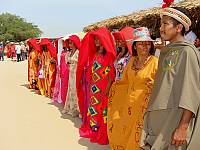on the Representative List could serve to heighten international awareness of the diversity of traditional textile techniques worldwide as evidence of human creativity; R.3: Safeguarding measures – for instance, holding workshops and training programmes and organizing exhibitions – are underway with the participation of the community and au...19 November 2010
Nairobi
tural Heritage of Humanity, described as follows: The Azerbaijani carpet is a traditional handmade textile of various sizes, with dense texture and a pile or pile-less surface, whose patterns are characteristic of Azerbaijan’s many carpet-making regions. Carpet making is a family tradition transferred orally and through practice. Men shear sheep...19 November 2010
Nairobi
cular architecture settlements, traditional dance, performed by the local community group members, and a tais traditional textile weaving workshop in Cova Lima District. ,Capacity-Building on the Implementation of the 2003 Convention for the Safeguarding of Intangible Cultural Heritage in Timor-Leste, Dili,...10 April 2012 - 14 April 2012
Dili
9 August: UNESCO celebrates the International Day of the World’s Indigenous People
In Timor-Leste, the production of Tais, a traditional textile, is a role reserved for women, who are also responsible for passing the knowledge and skills on to the next generation. >... international
5 August 2022
aditional Culture (Alternate): ● CIOFF България / CIOFF Bulgaria / CIOFF Bulgarie China Traditional Li textile techniques: spinning, dyeing, weaving and embroidering 00302 (Examiner): ● Craft Revival Trust - CRT Edric Liang Bin Ong (Alterna...
eveloping safeguarding measures to ensure the viability of the oral expressions, music and traditional knowledge (textile art and agricultural practices) of the Aymara communities of Bolivia (La Paz-Oruro-Potosí), Chile (Tarapacá-Arica-Parinacota-Antofagasta) and Peru (Tacna-Puno-Moquegua). The activities, planned for implementation over the cour...2 October 2009
Abu Dhabi
lking, telling stories and singing folksongs. Each group member has a specific duty, such as cutting the textile, selecting ornaments and coloured threads, drawing and applying the ornaments, embroidering needlepoint images and sewing the cloth. A leader controls operations, takes orders for embroidery products, locates raw materials, manages produ...4 December 2015
Windhoek
stan relates to the production of traditional Turkmen carpets and carpet products: hand-woven woolen textile products decorated with ornamental art. The carpets feature a dense texture ornamented with characteristic coloured patterns pertaining to one of the five main Turkmen tribes. They are characterized by patterns forming clear linear geometric...14 December 2019
Bogotá
ding: Weavers in villages throughout Sumba Island on the Indonesian archipelago create woven cotton textiles that are renowned for their beauty and the great variety of patterns and motifs, and rich in cultural values related to the life and environment of the Sumba people. The weaving is carried out and transmitted by women, who spin the cotton,...7 December 2013
Baku
the local culture of the regions. Traditional indigo blue-dyeing does not end with printing, however: the textile chain involves preparing the raw materials and spinning, weaving, finishing, printing and dyeing them. Nowadays, businesses engaged in the practice mainly comprise small, family-owned workshops, run by the second to seventh generation...1 December 2018
Port Louis
